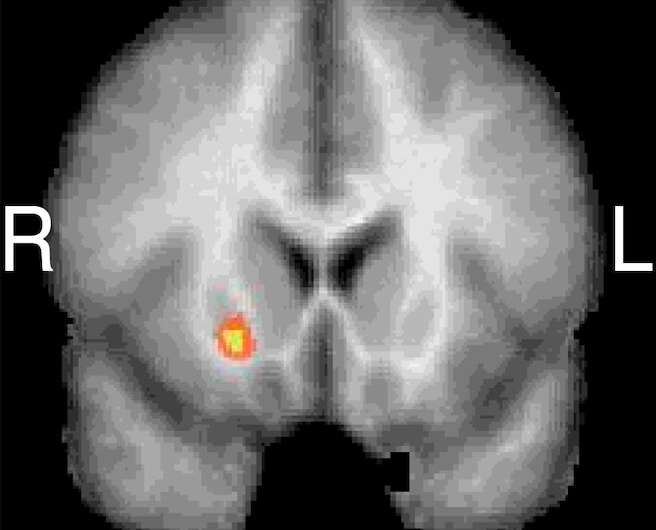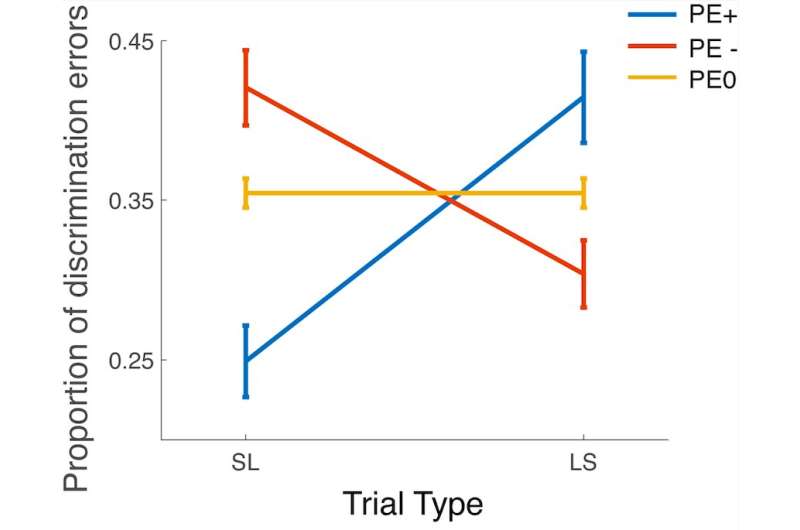Image showing activation in the Basal Ganglia. In the highlighted location, brain activation is opposite for positive and negative prediction errors in correct/incorrect time perception. The researchers suggest that the bias in time perception due to the presence of prediction errors might have originated from the interaction between time and PE in this brain region. Credit: Toren, Aberg & Paz.
Humans can sometimes perceive the passing of time differently, for instance, feeling as though an hour passed very quickly or that a few minutes went by extremely slowly. This suggests that the human perception of time is subjective and can be affected by many factors that can cause people to perceive the same amount of time as longer or shorter than it actually is.
Researchers at the Weizmann Institute of Science in Israel have recently carried out a fascinating study exploring if and how prediction errors can bias how different individuals perceive the passing of time. Their paper, published in Nature Neuroscience, shows that time perception can be influenced by both positive and negative prediction errors, while also identifying the putamen as a brain region responsible for biased time perception.
"Our lab studies, among other things, the process of learning from errors (reinforcement learning)," Rony Paz, head of the lab that carried out the study, told MedicalXpress. "Dopaminergic brain activation in a structure called the basal ganglia (BG) is known to be related to reinforcement learning in general, and reward prediction errors processing in particular. BG activation is also related to time perception required for motor functions that our brain controls."
For many years, time perception and human prediction errors were seen as almost entirely independent processes. The study by Paz and his colleagues challenges this idea, suggesting that these two elements are, in fact, deeply interlinked.
"Time perception and prediction error computation have often been considered to be mostly independent processes," Paz said. "The core idea of our study was to challenge this notion. Since the perception of time is subjective and was shown to be biased by many factors, and since both functions are processed in the same brain circuits, the two might interact and either aid or interfere with each other."
The main behavioral result collected by the researchers (i.e., how participants estimated time in different conditions). Higher location in the plot indicates higher error-rate in time perception. The orange line shows time perception when outcome is expected, while red/blue lines are time perception during PE-/PE+ respectively. It can be seen that time perception is biased for both PE-/PE+ (compared to expectation PE0) but in opposite directions. Credit: Toren, Aberg & Paz.
The key objective of the recent work by Paz and his colleagues was to investigate whether time perception is influenced by prediction errors, and if it is, to identify the neural underpinnings of this process. To achieve this, the researchers designed a behavioral task executed inside an fMRI scanner, in which participants are presented with different pairs of images on a screen, displayed for various amounts of time.
During each trial, the group of participants they recruited were asked to decide which of two images they saw on the screen was displayed for the longer amount of time. The images were overlaid with numbers that represented monetary gains and losses, as these would lead to predictions and errors.
"This design allowed us to measure time perception with a wide range of time differences, and importantly, in the presence of predicted vs. unpredicted outcomes," Paz explained. "The use of monetary gains and losses offers the possibility to differentiate between positive prediction errors (i.e., getting more than you expect) and negative prediction errors (i.e., getting less than you expect)."
As those who took part in their experiment were inside an fMRI scanner, the researchers were able to collect brain imaging data that could shed some light on the neural underpinnings of biased time perception. They then used computational modeling approaches to analyze the data they collected and investigate brain activation in the presence of positive or negative prediction errors. These analyses yielded a number of interesting results, highlighting the link between time perception and positive/negative prediction errors and identifying the putamen (located within the BG) as the brain region responsible for this interaction.
"Firstly, we found that prediction errors do indeed bias time perception, which was not known before," Paz said. "Moreover, we were able to identify the characteristics of this cognitive bias: Time is overestimated when positive errors occur (i.e., when a user receives more than he expected) and is underestimated when negative errors occur. The observation that two different functions processed in the same brain circuits can interact might have implications on many other processes executed in similar brain circuits."
Paz and his colleagues are among the first to provide evidence of the interaction between time perception and human prediction errors, while also identifying the brain region where this interaction 'takes place' (i.e., the putamen). The results they gathered could serve as a basis for other studies exploring the neural underpinnings of time perception biases. In addition, this study could shed light on the complexities and neural dynamics of diseases associated with dysfunctions of the BG, such as Parkinson's disease (PD), which affects people's ability to learn and accurately perceive the passing of time.
More information: Ido Toren et al. Prediction errors bidirectionally bias time perception, Nature Neuroscience (2020). DOI: 10.1038/s41593-020-0698-3
Journal information: Nature Neuroscience
© 2020 Science X Network

























